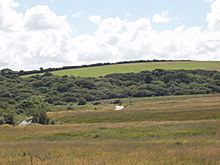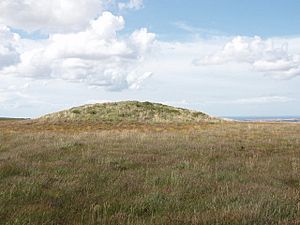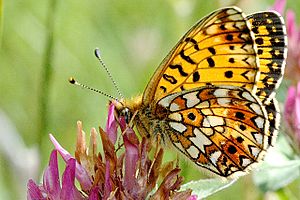Rosenannon Downs facts for kids
| Site of Special Scientific Interest | |

Heathland of Rosenannon Downs
|
|
| Area of Search | Cornwall |
|---|---|
| Coordinates | 50°28′17″N 4°53′00″W / 50.4713°N 4.8834°W |
| Interest | Biological |
| Area | 135.5 hectares (1.355 km2; 0.5232 sq mi) |
| Notification | 1951 |
Rosenannon Downs is a special nature reserve in mid Cornwall, England. It's officially called "Rosenannon Bog and Downs" and is a Site of Special Scientific Interest (SSSI). This means it's a very important place for nature.
The reserve is home to many different plants and animals. It even has ancient burial mounds from the Bronze Age! The Cornwall Wildlife Trust helps look after this amazing place.
Contents
Exploring Rosenannon Downs: A Special Place
This SSSI covers about 135.5 hectares (that's like 335 football fields!). It was first recognized as a special site in 1979. You can find it north of a small village called Rosenannon, about 6 kilometers (4 miles) southwest of Wadebridge.
The streams that start here flow into the River Camel Valley. This river area is also a very important natural spot.
The Cornwall Wildlife Trust owns and manages Rosenannon Downs. They have been looking after the land since 1999. It was given to them in 2009 by Theresa Knowles, who wanted to protect it.
A Glimpse into the Past: History of the Downs
On the northern side of the reserve, there are three ancient burial mounds. These mounds are called barrows. They were built around 2500 BC, which was during the Bronze Age. Imagine how old they are!
This special site used to be called "Rosenannon Bog." But it was renamed after more land was added to make it bigger. The Downs haven't had animals grazing on them since the 1960s. However, there are plans to bring back grazing animals to help manage the land.
Amazing Wildlife and Nature at Rosenannon Downs
The reserve has two main types of natural areas: heathland and bogland. Both of these habitats are home to many different kinds of plants and animals.
Plants of Rosenannon Downs
The dry heath areas are full of plants like common heather. Bell heather and western gorse are also very common here. You can also find bristle bent and purple moor-grass.
Other interesting plants in this habitat include heath milkwort and lousewort. There's also saw-wort, deer grass, and the beautiful heath spotted-orchid.
The wet heath areas also have purple moor-grass. Bog myrtle and cross-leaved heath are also very common here. In the wetter parts, you might see black bogrush.
In the wet hollows, you can find bog mosses. There's also the round-leaved sundew, which is a carnivorous plant. It catches insects for food!
The valley bog habitat has cross-leaved heath and purple moor-grass. It also supports bog asphodel and bog pimpernel. You might see common cottongrass, lesser skullcap, and pale butterwort.
White beak-sedge also grows here. Two rare plants in Britain, royal fern and wavy St. John's-wort, can be found in the bogland. A woodland surrounds the valley bog. It mainly has sessile oak trees and different kinds of willows.
On the southern edge of the Downs, there's an area with shrubs. This area is home to a special plant called Cornish bladderseed.
Animals of Rosenannon Downs
Many birds live, nest, and feed on the heathland here. You might spot the common snipe or the curlew. The meadow pipit also lives here.
The stonechat is another bird found on the Downs. This bird's numbers are decreasing across the country. Other birds seen at the reserve include the hen harrier and the Montagu's harrier. The skylark, known for its beautiful song, also visits.
Protecting Rosenannon Downs: Conservation Efforts
The Cornwall Wildlife Trust is working hard to protect Rosenannon Downs. They have permission to put up fences. This will allow them to bring cattle back to graze the land.
Grazing helps manage the land in several ways. It can reduce the risk of large, uncontrolled fires. These fires can be very damaging to the habitat.
Grazing also helps a special butterfly called the small pearl-bordered fritillary. The caterpillars of this butterfly eat marsh violet plants. These plants are low-growing and can be outcompeted by taller purple moor-grass. Cattle grazing helps keep the grass shorter, allowing the marsh violets to grow.
Fencing for cattle grazing began in December 2011. Sadly, there have been uncontrolled fires on the reserve. These fires are thought to have been started by people. In March 2012, one fire burned about 52 hectares of the reserve.



